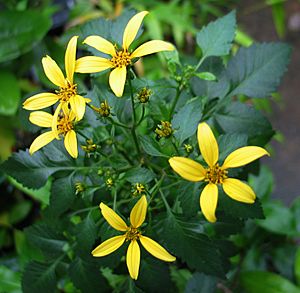Molokaʻi koʻokoʻolau facts for kids
Quick facts for kids Wiebke's beggarticks |
|
|---|---|
 |
|
| Conservation status | |
| Scientific classification | |
| Genus: |
Bidens
|
| Species: |
wiebkei
|
| Synonyms | |
|
|
Bidens wiebkei, also known as the Molokaʻi koʻokoʻolau or Wiebke's beggarticks, is a special type of flowering plant. It belongs to the plant family called Asteraceae, which includes daisies and sunflowers. In the Hawaiian language, plants from its genus Bidens are often called kokoʻolau or koʻokoʻolau. This unique plant is found only on the island of Molokaʻi in the beautiful Hawaiian Islands. Sadly, there are fewer than 1000 of these plants left in the world, found in only three small areas.
Contents
What is Wiebke's Beggarticks?
This plant is a perennial herb. This means it's a plant that lives for more than two years and doesn't have a woody stem like a tree. It can grow straight up to about one meter tall, which is roughly the height of a small child.
Its leaves are "compound," meaning each leaf is made up of several smaller leaflets. When it blooms, it has clusters of flower heads. These flower heads look like single flowers but are actually made of many tiny flowers grouped together. The outer parts of these flower heads are bright yellow, like the petals of a daisy.
Where Does It Live?
The natural habitat of Wiebke's beggarticks includes lowland moist forests and moist shrubland. These are places with lots of rain and green plants. It needs these specific conditions to grow and thrive.
Why is This Plant in Danger?
Wiebke's beggarticks is a critically endangered plant. This means it is at a very high risk of disappearing forever. Its biggest problem is habitat loss. This happens when the places it naturally grows are destroyed or changed.
Threats to Its Survival
Several things are making it hard for this plant to survive:
- Invasive Weeds: Invasive weeds are plants that are not native to Hawaii. They grow very fast and take over the space and resources that native plants like Bidens wiebkei need.
- Brush Fires: Brush fires can quickly destroy large areas of forest and shrubland where these plants live.
- Overgrazing: Overgrazing happens when too many animals eat the plants in an area. This can prevent new plants from growing and damage existing ones.
- Human Construction: Building new roads, homes, or other structures can also destroy the plant's natural home.
Because of these threats, there are very few Bidens wiebkei plants left. Protecting their habitat is very important to help them survive.


